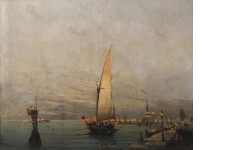TITΛΟΣ ΕΡΓΟΥΣΚΗΝΗ ΛΙΜΑΝΙΟΥ
ΔΙΑΣΤΑΣΕΙΣ ΕΡΓΟΥΎψος : 56
Πλάτος : 71
ΥΛΙΚΟ ΚΑΤΑΣΚΕΥΗΣΕλαιογραφία (Λάδι σε καμβά)
ΥΠΟΓΡΑΦΗ ΚΑΛΛΙΤΕΧΝΗΚάτω Αριστερά
ΧΡΟΝΟΛΟΓΗΣΗ
ΕΛΕΓΧΟΣ ΓΝΗΣΙΟΤΗΤΑΣΔεν έχει ελεγχθεί

Footnotes
Provenance:
Private collection, Athens.
The scholars who have studied the artists work agree that Volanakis is at his best when rendering peace and calm1. He is simply interested in a vertical and a horizontal to create a metaphysical stillness. Thats why he prefers tranquil sea2 According to M. Vlachos, a leading authority on the artist, Volanakis is in constant communion with nature, in a composite relationship from which poetry emerges. Especially his love for and familiarity with small vessels produced works of pure lyricism,3 in which the sails and tall masts chant the harmonies of subdued colours and bring life to the scene.4
A serenely luminous painting from Volanakis Greek period (1884-1907), Harbour scene combines all three of the artists favourite themes (the sea, the vessel and the sky) showcasing delicacy of touch, immediacy of execution, harmony of proportion and colour sensitivity, while exhibiting all the characteristic qualities of the artists famous harbour views: pellucid waters, crisp reflections, capacious skies and a composition which is tightly structured around a series of solid verticals, posited here along the entire length of the picture plane, from the makeshift reef marker on the left to the lampposts on the jetty to the cluster of upright masts on the far right.
The low horizon allows a strongly lyrical and luminous sky to dominate the scene, encapsulating human activity in the lowermost quarter of the composition and evoking a substantial visual depth in the vein of the 17th century Dutch masters, especially Simon de Vliger and Jan van de Cappelle.5 Like them, Volanakis was fascinated with the ways in which fleeting visual phenomena and ephemeral subjects such as air and light could be rendered. The suggestive atmosphere, the sensitive and fluid handling of the paint and the skys radiance reflected in the gentle, mirror-like waters, are combined in a harmonious composition and lyrical interpretation of nature. The loving delicacy with which Volanakis observed the seascape extends to the scene as a whole, capturing the intangible qualities of light and the wonderful stillness of the hour. Much more than a harbour scene, this evocative painting aspires to a revelation of marine atmosphere.
1. M. Vlachos, The Painter Constantinos Volanakis (doctoral thesis) [in Greek], Athens 1974, p. 125, note 2; S. Lydakis, Constantinos Volanakis [in Greek], Adam, Athens 1997, p. 174.
2. Lydakis, Volanakis, a Pioneer, Kathimerini daily (Epta Imeres), 22.02.1998, p. 14.
3. Vlachos, The Painter Constantinos Volanakis, p. 105 and Constantinos Volanakis in Greek Painters [in Greek], vol.1, Melissa, Athens 1974, p. 202.
4. D. Evangelidis, Greek Art [in Greek], Athens 1969, p. 128.
5. See Turmoil and Tranquillity, the Sea through the Eyes of Dutch and Flemish Masters, 1550-1700, (exhibition catalogue), National Maritime museum, London 2008.